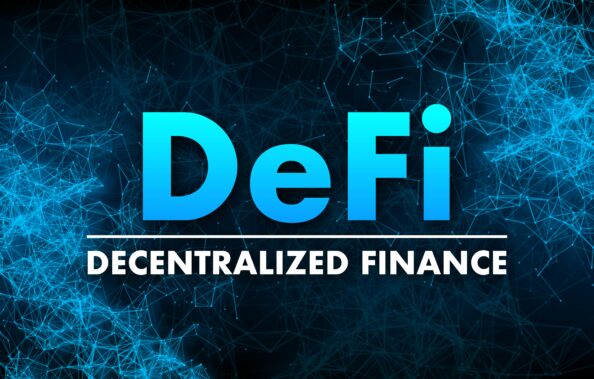
Yield farming, also known as liquidity mining, is a new trend in the world of cryptocurrency that has taken the market by storm. It refers to the process of earning interest or rewards for providing liquidity to a decentralized finance (DeFi) platform. The concept of yield farming is built on the principles of decentralized finance, which aims to create a financial system that operates independently of intermediaries such as banks. Yield farming allows investors to earn high returns on their investments in a short period of time, as they provide liquidity to DeFi platforms that offer high-interest rates. This new trend is attracting a lot of attention from investors, as it offers an alternative to traditional investment options that typically have low returns.
Yield farming is a new trend in the cryptocurrency world that involves earning interest or rewards for providing liquidity to a decentralized finance (DeFi) platform. It operates on the principles of decentralized finance, which aims to create a financial system that operates independently of intermediaries such as banks.
By participating in yield farming, investors can earn high returns on their investments in a short period of time by providing liquidity to DeFi platforms that offer high-interest rates. The idea is to incentivize users to contribute their assets to these platforms, thereby increasing the liquidity and stability of the DeFi ecosystem.
Yield farming has gained popularity in recent times, attracting a lot of attention from investors looking for alternative investment options with higher returns compared to traditional investment options. However, it is important to note that yield farming comes with its own set of risks and challenges, as the DeFi space is largely unregulated.

Yield farming works by allowing investors to provide liquidity to a decentralized finance (DeFi) platform in exchange for interest or rewards. The process typically involves depositing funds into a liquidity pool on the DeFi platform, which is then used to trade various cryptocurrencies. The liquidity provided by investors helps to increase the stability and liquidity of the DeFi platform, allowing it to offer high-interest rates to its liquidity providers.
When a user participates in yield farming, they earn a portion of the fees generated from trading activities on the platform, as well as any additional rewards offered by the platform. The rewards can come in the form of additional tokens or cryptocurrency, which can then be traded or sold on the market. The returns generated from yield farming can be substantial, making it an attractive option for investors looking to maximize their returns.
Yield farming has become popular for a number of reasons, including
Yield farming and liquidity mining refer to the same concept in the world of decentralized finance (DeFi). Both terms describe the process of earning interest or rewards for providing liquidity to a DeFi platform.
In yield farming, investors deposit their funds into a liquidity pool on a DeFi platform, and in exchange, they receive a portion of the fees generated from trading activities on the platform, as well as any additional rewards offered by the platform. The goal of yield farming is to incentivize users to provide liquidity to DeFi platforms, thereby increasing the stability and liquidity of the DeFi ecosystem.
In liquidity mining, the focus is on incentivizing users to provide liquidity to decentralized exchanges (DEXs), which allows for more efficient trading and reduces the risk of market manipulation. The process is similar to yield farming, where investors deposit their funds into a liquidity pool and receive rewards for their participation.
In essence, yield farming and liquidity mining refer to the same process of earning rewards for providing liquidity, but yield farming is a broader term that encompasses liquidity mining, as well as other DeFi activities that incentivize liquidity provision.

Yield farming and crypto mining are two different concepts in the world of cryptocurrency.
Crypto mining refers to the process of verifying transactions on a blockchain network and adding new blocks to the blockchain, in exchange for rewards in the form of newly minted cryptocurrency. Crypto mining requires specialized hardware and technical knowledge, and the rewards received are proportional to the computing power contributed to the network.
Yield farming, on the other hand, involves earning interest or rewards for providing liquidity to a decentralized finance (DeFi) platform. This can be done by depositing funds into a liquidity pool on the DeFi platform and participating in various trading activities. The rewards received from yield farming come from a combination of trading fees and additional rewards offered by the platform. Unlike crypto mining, yield farming does not require specialized hardware, and the rewards received are proportional to the amount of liquidity provided to the platform.
In summary, crypto mining is focused on verifying transactions and adding new blocks to a blockchain network, while yield farming is focused on earning rewards for providing liquidity to a DeFi platform.
Yield farming and staking are both investment strategies in the world of cryptocurrency, but they have distinct differences.
Staking refers to the process of holding and locking up a certain amount of cryptocurrency in a wallet to support the operations of a blockchain network. Staking helps to secure the network and enables users to participate in the consensus process, in exchange for rewards in the form of newly minted cryptocurrency or a portion of transaction fees. Staking is typically done with Proof-of-Stake (PoS) cryptocurrencies, where users can earn rewards simply by holding the cryptocurrency in a wallet.
Yield farming, on the other hand, involves earning interest or rewards for providing liquidity to a decentralized finance (DeFi) platform. This can be done by depositing funds into a liquidity pool on the DeFi platform and participating in various trading activities. The rewards received from yield farming come from a combination of trading fees and additional rewards offered by the platform. Unlike staking, yield farming is not limited to specific blockchain networks or cryptocurrencies and can be done with a wider range of digital assets.
In summary, staking is focused on supporting the operations of a blockchain network by holding and locking up the cryptocurrency, while yield farming is focused on earning rewards for providing liquidity to a DeFi platform.
Yield farming can be broadly categorized into several different types based on the activities performed by the user to earn rewards.
Providing liquidity
This type of yield farming involves depositing funds into a liquidity pool on a decentralized finance (DeFi) platform to provide liquidity for trading activities. Users receive rewards in the form of trading fees and additional incentives offered by the platform.
Lending
This type of yield farming involves lending out digital assets to borrowers in exchange for interest. Investors deposit their digital assets into a lending pool, where they are then lent out to borrowers who need funds for various purposes, such as trading, investing, or paying bills. The interest earned on the loans is shared between the lender and the platform, with the lender receiving a portion of the interest as reward for their participation in yield farming.
Borrowing
Borrowing involves borrowing digital assets to invest in other DeFi opportunities, such as yield farming. Borrowers pay interest on the borrowed assets and may receive additional rewards from their investments. Borrowers can access funds by depositing collateral in the form of digital assets into a borrowing platform. The platform then provides the borrower with the funds needed for their investment activities. Borrowers must pay interest on the borrowed funds and are responsible for repaying the borrowed funds and interest.
POS staking
POS Staking involves holding and staking a certain amount of cryptocurrency in a wallet to support the operations of a Proof-of-Stake (PoS) blockchain network. Users receive rewards in the form of newly minted cryptocurrency or a portion of transaction fees. Investors hold and “stake” their digital assets in a wallet that supports a PoS blockchain network. The assets are used to validate transactions and secure the network, and in exchange, the staker is rewarded with a portion of the newly minted cryptocurrency or transaction fees. The rewards are proportional to the number of assets staked and the length of time the assets are staked.
LP staking
LP staking involves participating in liquidity provision for DeFi platforms. Investors deposit their funds into a liquidity pool and receive rewards in the form of trading fees and additional incentives offered by the platform.
Native token staking
This type of yield farming is often used to support the operations of a blockchain network and to secure its consensus mechanism. Investors hold and “stake” a certain amount of the blockchain’s native token in a wallet. The staked tokens are used to validate transactions and secure the network, and in exchange, the staker is rewarded with newly minted tokens or a portion of transaction fees. The rewards are proportional to the number of tokens staked and the length of time they are staked.

The calculation of yield farming returns is a complex process that depends on several factors. Here are some of the key components that are taken into account when determining the returns from yield farming activities:

Collateralization refers to the practice of using assets as collateral to secure a loan or other financial obligation. In the context of decentralized finance (DeFi), collateralization is a critical component of many financial products and services, such as borrowing, lending, and stablecoin issuance.
In DeFi, borrowers typically provide a certain amount of cryptocurrency or other digital assets as collateral when taking out a loan. The collateral is held in a smart contract, which acts as a security for the loan. If the borrower is unable to repay the loan, the lender has the right to liquidate the collateral to recoup the funds.
The amount of collateral required for a loan is typically determined by the loan-to-value (LTV) ratio, which is a measure of the value of the loan relative to the value of the collateral. A high LTV ratio means that the loan is riskier, as the lender is exposed to greater potential losses if the collateral value decreases.
Collateralization is a key factor in the stability and security of the DeFi ecosystem, as it helps to mitigate the risk of default and reduces the likelihood of financial losses for lenders. By using collateral to secure loans, DeFi protocols are able to offer more attractive loan terms, including lower interest rates, compared to traditional financial institutions.

Liquidation risk
Liquidation risk refers to the danger that an investor’s assets may be liquidated or sold in order to repay a loan or other financial obligation in the event of default.
As investors often provide cryptocurrency or other digital assets as collateral to earn rewards from lending, borrowing, or other activities. If the value of the collateral decreases significantly, it may fall below a certain threshold, known as the “liquidation level.” When this occurs, the collateral may be automatically sold in a process known as “liquidation” in order to repay the outstanding debt and protect the lender’s interests. If the liquidation price is lower than the original value of the collateral, the investor may lose a portion or all of their investment.
Impermanent loss
Impermanent loss is a risk that can arise when participating in yield farming or providing liquidity to decentralized finance (DeFi) protocols. It refers to the phenomenon where the value of an investment decreases due to changes in the relative prices of the assets being held.
In yield farming, liquidity providers contribute cryptocurrency to a pool in exchange for rewards, thus they provide the necessary liquidity to facilitate trades and earn a share of the transaction fees generated. However, if the price of the assets in the pool changes, the value of the LP’s investment may decrease, even if the overall value of the pool remains unchanged. In some cases, the impermanent loss can be substantial, potentially wiping out the rewards earned from yield farming and leaving the LP with a net loss.
Smart сontract risk
Smart contract risk can be exacerbated in yield farming because the high levels of capital being deployed in these protocols, along with the rapid pace of innovation in DeFi, can increase the likelihood of flaws or vulnerabilities being present. Additionally, the complex nature of DeFi protocols and yield farming can make it difficult for even experienced investors to fully understand the risks involved.
Exit scams
Exit scams can occur when the creators or developers of a project or protocol suddenly disappear or shut down the project, taking the invested funds with them. This type of risk can be particularly concerning in the context of yield farming because of the high levels of capital being deployed in these protocols, along with the rapid pace of innovation in DeFi.
Exit scam risk can be exacerbated by the lack of regulation in the cryptocurrency and DeFi space, as well as the complex nature of many yield farming protocols. This can make it difficult for even experienced investors to fully understand the risks involved and assess the likelihood of an exit scam occurring.
Platform hacks
Hacks can occur when malicious actors gain unauthorized access to a platform or protocol, allowing them to steal funds or manipulate the system. This type of risk can be particularly concerning in the context of yield farming because of the high levels of capital being deployed in these protocols, along with the rapid pace of innovation in DeFi.

Regulatory risk
Regulatory risk can arise from a number of sources, including changes in laws and regulations at the local, national, or international level, as well as enforcement actions taken by regulators. This type of risk can be particularly concerning in the context of yield farming because of the high levels of capital being deployed in these protocols, along with the rapid pace of innovation in DeFi.
Volatility
Volatility can be particularly concerning in the context of yield farming because of the high levels of capital being deployed in these protocols, along with the rapid pace of innovation in DeFi. The cryptocurrency market is known for its high levels of volatility, and this is reflected in the prices of many DeFi tokens, which can experience significant price swings in a short period of time. Volatility can arise from a number of sources, including changes in market sentiment, shifts in investor behavior, or even technical issues with a platform or protocol.

Compound Finance
Compound Finance is a decentralized lending and borrowing platform that allows users to earn interest on their deposits and borrow assets at variable interest rates. Compound uses a unique token, cTokens, to represent assets deposited into the platform.
Aave is a decentralized lending platform that allows users to deposit and lend out their assets to earn interest. Aave also supports flash loans, which allow users to borrow funds without collateral for a short period of time.
Uniswap is a decentralized exchange (DEX) that uses an automated market maker (AMM) model to facilitate trading. Uniswap allows users to provide liquidity to the platform and earn a share of the trading fees as rewards.
Curve Finance is a decentralized yield farming protocol built on the Ethereum blockchain. It aims to provide a more efficient and stable platform for trading stablecoins, which are cryptocurrencies designed to maintain a stable value relative to a specific asset or basket of assets.
Curve Finance offers a range of stablecoins, including USDC, DAI, and sUSD, among others, and allows users to trade these assets with low slippage and minimal impermanent loss. The platform uses an automated market maker (AMM) model to facilitate trading and a bonding curve to determine token prices.
Balancer
Balancer is built on Ethereum and provides a platform for yield farming, allowing users to earn returns by providing liquidity to its pools and participating in token swaps. Balancer offers a wide range of pools, each consisting of multiple assets, allowing users to diversify their portfolios and minimize risk.
One of the key features of Balancer is its smart pool technology, which automatically rebalances assets in each pool to maintain its target weight. This helps to minimize impermanent loss and ensures that users receive consistent yields over time. Additionally, Balancer uses a bonding curve to determine token prices, which helps to minimize slippage and improve liquidity.
PancakeSwap is a decentralized exchange (DEX) built on the Binance Smart Chain (BSC) that provides a platform for yield farming. It’s designed to make it easy for users to trade and earn returns on their crypto assets. PancakeSwap allows users to provide liquidity to its pools, trade tokens, and earn rewards in the form of CAKE tokens, the platform’s native currency.
One of the key features of PancakeSwap is its simplified user interface, which makes it easy for even those new to crypto to get started with yield farming. It also has a low barrier to entry, with smaller minimum investment amounts compared to some other yield farming protocols.
SushiSwap
SushiSwap is a decentralized exchange (DEX) and automated market maker (AMM) that was created as a fork of the popular Uniswap protocol, with a focus on providing more rewarding incentives to its liquidity providers. The platform operates on the Ethereum blockchain and supports the trading of a wide range of tokens.
One of the key features of SushiSwap is its SUSHI token, which serves as the platform’s native currency and is used to incentivize liquidity provision. By providing liquidity to the platform, users can earn SUSHI tokens, which can then be staked for additional returns or traded on various exchanges.
Venus Protocol is a decentralized finance (DeFi) platform that aims to provide yield farming opportunities and decentralized exchanges for various cryptocurrencies. It operates on the Binance Smart Chain and supports the trading of various Binance Chain tokens. By providing liquidity to the platform, users can earn interest on their deposited assets, as well as VX, the platform’s native token, which can be used to claim a share of the platform’s trading fees.
Yearn.finance is a yield optimization platform that allows users to maximize their returns on deposited assets through a variety of strategies, including yield farming, liquidity provision, and lending. The platform operates on the Ethereum blockchain and supports the trading of a wide range of Ethereum-based tokens. By using Yearn.finance, users can automatically shift their deposits between different DeFi protocols in search of the highest returns.
Instadapp
Instadapp is a decentralized finance platform that provides access to a variety of DeFi protocols and services, including yield farming, lending, borrowing, and trading. It operates on the Ethereum blockchain and allows users to manage their DeFi portfolio from a single interface. By using Instadapp, users can take advantage of yield farming opportunities, maximize returns on their deposited assets, and access a range of DeFi services and protocols.
Before starting yield farming, it is important to do thorough research on the yield farming protocols and the assets that they offer. This includes reading whitepapers, comparing different yield farming platforms, and understanding the risks involved. Researching the reputation and track record of the yield farming protocols is also crucial, as well as understanding the expected returns, interest rates, and the duration of the investment.
Then you need to connect your crypto wallet to the yield farming platform or fund your account on the platform. This will allow you to deposit your cryptocurrency and start earning interest.

Once your wallet is connected or your account is funded, you can then deposit your cryptocurrency and stake it on the yield farming platform. This involves locking up your cryptocurrency in exchange for interest-bearing tokens, which you can later sell or trade.
Yield farming usually pays out rewards in the form of interest-bearing tokens, which can be sold or traded on the platform. The rewards are paid out at regular intervals, and you can track your earnings through your account dashboard. After a set period, you can withdraw your cryptocurrency, along with your accumulated interest.
The future of yield farming is highly dependent on the continued growth and development of the DeFi sector. At present, the yield farming trend is on the rise, and many investors are seeking new and innovative ways to earn passive income through their cryptocurrency holdings.
One of the biggest prospects for yield farming is the potential for high returns. With interest rates on traditional financial products such as savings accounts and bonds at historic lows, yield farming offers the potential for much higher returns, provided that the investment is made wisely and the risks are well understood.
Another prospect for yield farming is the growing number of DeFi protocols and yield farming platforms. As the DeFi sector continues to grow, there is likely to be a corresponding increase in the number of yield farming opportunities available to investors.
The prospects for yield farming in the cryptocurrency industry are promising, but it’s important to approach yield farming with caution and to carefully consider the risks involved before making any investment decisions.
Yield farming has quickly become one of the most popular trends in the cryptocurrency industry, as investors seek new and innovative ways to earn passive income from their cryptocurrency holdings. The basic concept behind yield farming is to lend, stake, or provide liquidity to a DeFi protocol in exchange for rewards in the form of interest or token rewards.
However, yield farming is not without risks, and it’s important to carefully consider the risks involved before making any investment decisions. Some of the risks associated with yield farming include the risk of platform hacks, smart contract risks, and liquidity risks.
Despite these risks, the prospects for yield farming in the cryptocurrency industry are promising, and there is likely to be a continued increase in the number of yield farming opportunities available to investors. Yield farming offers the potential for high returns, and is a great way for cryptocurrency investors to diversify their portfolios and earn passive income. But before you decide to jump into the world of Yield farming, it would be better to contact blockchain consultants who are ready to help you to get the utmost of your investments.